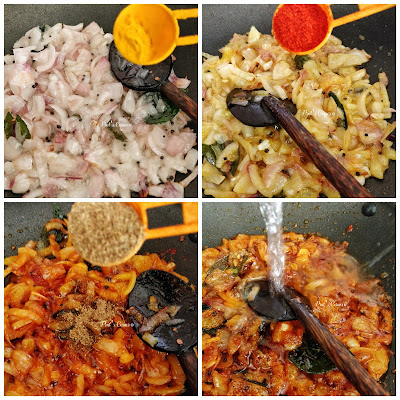Kottayam style Fish Curry (Meen mulakitathu)
Kottayam style fish curry/Meen kudampuli ittu vattichathu /Meen mulakitathu is a traditional
fish curry of Kerala. Again, this recipe is from my mom-in-law which is very well known in our family.
Ingredients
Fish - 1/2 Kg (cleaned )
Mustard seeds - 1/4 tspn
Fenugreek seeds - less than 1/4 tspn (10-12 nos.)
Ingredients
Fish - 1/2 Kg (cleaned )
Kashmiri Chilli Powder - 3 to 4tbspn
Chilli powder - 1 tbspn
Turmeric Powder - 1/4 tspn
Coconut Oil - 2tbspn + 1 tbspn to drizzle at the endMustard seeds - 1/4 tspn
Fenugreek seeds - less than 1/4 tspn (10-12 nos.)
Fenugreek Powder - 1/4 tspn
Shallots - 5nos. finely sliced
Ginger - 1 inch finely sliced
Garlic - 4 finely sliced
Kudampuli (Malabar Tamarind) - wash and soak 1 or 2 pieces
in water according to the sourness of the puli
Boiling water
Salt to taste
Curry Leaf
Method:
1. In a pan (cheenachatti), add Chilli powder and Turmeric powder. Keep the pan in low flame
Shallots - 5nos. finely sliced
Ginger - 1 inch finely sliced
Garlic - 4 finely sliced
Kudampuli (Malabar Tamarind) - wash and soak 1 or 2 pieces
in water according to the sourness of the puli
Boiling water
Salt to taste
Curry Leaf
Method:
1. In a pan (cheenachatti), add Chilli powder and Turmeric powder. Keep the pan in low flame
and keep mixing. The powders has to be just heated (no need wait until it changes the color).
Immediately transfer the ingredients to a mixer jar and add 1 small piece ginger, garlic and
Immediately transfer the ingredients to a mixer jar and add 1 small piece ginger, garlic and
shallots (from the sliced). Add enough water and grind to a smooth paste
(this gives a very good consistency to the fish curry)
2. Heat a Manchatty (earthernware pot) and add 2 tbspn of coconut oil.
Add mustard seeds, fenugreek seeds and allow it to splutter. Then add add curry leaves.
3. Add sliced shallots, Ginger and garlic. Saute until it turns light golden color.
4. Once it turns to light golden color, add chilli and turmeric paste and saute for few seconds
2. Heat a Manchatty (earthernware pot) and add 2 tbspn of coconut oil.
Add mustard seeds, fenugreek seeds and allow it to splutter. Then add add curry leaves.
3. Add sliced shallots, Ginger and garlic. Saute until it turns light golden color.
4. Once it turns to light golden color, add chilli and turmeric paste and saute for few seconds
(in a very low flame). Now add salt.
break the fish). Add curry leaves and wait (5 min) until the water oozes out from fish
(keep the flame in low - med).
boil for 2 minutes (high flame). Now cover and cook in a low - medium
flame for 10 - 15 minutes or until you see oil on top (please do open and check the
curry in between). Now add a pinch of Fenugreek powder, a sprig of curry leaves
and drizzle 1tbspn of coconut oil and switch off the flame. Let the curry cool down completely
and serve with Kappa or rice.
1. Use good quality Kashmiri chilli powder for that fiery red color.
2. Using very little turmeric powder gives a reddish color to this fish curry (If we use more
turmeric powder, the color of the curry will change to brownish red)
3. Reheat the left over curry on the next day morning and night so that it stays good for 3 days
at room temp.(Also don't forget to remove the Kudam puli while reheating).
flame for 10 - 15 minutes or until you see oil on top (please do open and check the
curry in between). Now add a pinch of Fenugreek powder, a sprig of curry leaves
and drizzle 1tbspn of coconut oil and switch off the flame. Let the curry cool down completely
and serve with Kappa or rice.
:
Notes:1. Use good quality Kashmiri chilli powder for that fiery red color.
2. Using very little turmeric powder gives a reddish color to this fish curry (If we use more
turmeric powder, the color of the curry will change to brownish red)
3. Reheat the left over curry on the next day morning and night so that it stays good for 3 days
at room temp.(Also don't forget to remove the Kudam puli while reheating).



















